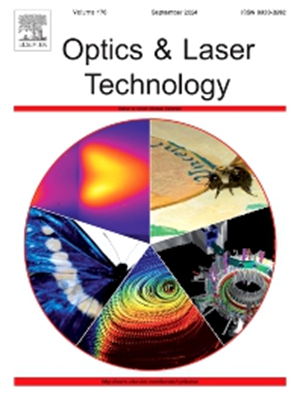Local defects prediction in laser additive manufacturing via multisensor monitoring strategy and multi-feature fusion convolutional neural network
IF 4.6
2区 物理与天体物理
Q1 OPTICS
引用次数: 0
Abstract
Online monitoring is essential for enhancing in-process quality control in laser additive manufacturing (AM) by enabling the early detection of defects, thereby preventing build failures. However, considering the intricate interplay of cross-scale multiphysics phenomena within the laser AM process, acquiring comprehensive state information that entirely depicts the mechanism of the forming process remains challenging when relying solely on a single sensor. Moreover, existing monitoring strategies lack sufficient exploitation of the heterogeneous features embedded in various types of process state information. Hence, accurately predicting localized defects in the laser AM process remains challenging. This paper proposes a localized defect prediction method in the laser AM process based on a multisensor monitoring strategy and the multi-feature fusion convolutional neural network (MFFCNN). A coaxially integrated CCD camera and dichromatic pyrometer are utilized to capture the morphological and thermal dynamics of molten pool, enabling in-situ sensing within the zone of laser-material interaction. To establish dataset labels, internal defects are detected using X-ray CT scanning, enabling the extraction of defect information for accurate annotation. A multisensor monitoring strategy is proposed, which maps the multisensor-captured process data to local defects according to their spatiotemporal relationships. Furthermore, a sampling mode using a rolling time window is employed for continual online monitoring, and three window lengths (0.2 s, 0.3 s, and 0.4 s) were evaluated to determine the optimal one. Given the purpose of sufficiently exploiting the wealth quality-related information found in multisensor-captured process data of molten pool, we propose the MFFCNN, incorporating a feature extraction module, a feature fusion module, and a decision-making module aimed at achieving precise defect prediction. Four feature fusion techniques, including feature concatenation, feature overlay, feature maximum coupling, and feature mean coupling, are systematically investigated to ascertain the most suitable method. Experimental results show that a rolling time window of 0.4 s, using the feature overlay method to fuse two-dimensional process temperature and in-process images, achieved the highest average accuracy of 93.68 %. The effectiveness of the proposed approach is further validated through comparative analysis with a single-sensor-based method without feature fusion.
基于多传感器监测策略和多特征融合卷积神经网络的激光增材制造局部缺陷预测
在线监测对于加强激光增材制造(AM)的过程质量控制至关重要,因为它可以早期发现缺陷,从而防止制造故障。然而,考虑到激光AM过程中跨尺度多物理场现象的复杂相互作用,仅依靠单个传感器获取完整描述成形过程机制的全面状态信息仍然具有挑战性。此外,现有的监控策略缺乏对嵌入在各种类型的过程状态信息中的异构特征的充分利用。因此,准确预测激光增材制造过程中的局部缺陷仍然具有挑战性。提出了一种基于多传感器监测策略和多特征融合卷积神经网络(MFFCNN)的激光增材加工缺陷局部预测方法。利用同轴集成CCD相机和二色高温计捕捉熔池的形态和热动力学,实现了激光-材料相互作用区域内的原位传感。为了建立数据集标签,使用x射线CT扫描检测内部缺陷,提取缺陷信息进行准确标注。提出了一种多传感器监测策略,将多传感器捕获的过程数据根据其时空关系映射到局部缺陷。此外,采用滚动时间窗的采样模式进行连续在线监测,并评估了三种窗口长度(0.2 s, 0.3 s和0.4 s)以确定最佳窗口长度。为了充分利用多传感器捕获的熔池过程数据中丰富的质量相关信息,我们提出了MFFCNN,结合特征提取模块、特征融合模块和决策模块,以实现精确的缺陷预测。对特征拼接、特征叠加、特征最大耦合和特征均值耦合四种特征融合技术进行了系统研究,以确定最适合的融合方法。实验结果表明,在0.4 s的滚动时间窗下,采用特征叠加方法融合二维过程温度和过程中图像,平均精度达到93.68%。通过与无特征融合的单传感器方法的对比分析,进一步验证了该方法的有效性。
本文章由计算机程序翻译,如有差异,请以英文原文为准。
求助全文
约1分钟内获得全文
求助全文
来源期刊
CiteScore
8.50
自引率
10.00%
发文量
1060
审稿时长
3.4 months
期刊介绍:
Optics & Laser Technology aims to provide a vehicle for the publication of a broad range of high quality research and review papers in those fields of scientific and engineering research appertaining to the development and application of the technology of optics and lasers. Papers describing original work in these areas are submitted to rigorous refereeing prior to acceptance for publication.
The scope of Optics & Laser Technology encompasses, but is not restricted to, the following areas:
•development in all types of lasers
•developments in optoelectronic devices and photonics
•developments in new photonics and optical concepts
•developments in conventional optics, optical instruments and components
•techniques of optical metrology, including interferometry and optical fibre sensors
•LIDAR and other non-contact optical measurement techniques, including optical methods in heat and fluid flow
•applications of lasers to materials processing, optical NDT display (including holography) and optical communication
•research and development in the field of laser safety including studies of hazards resulting from the applications of lasers (laser safety, hazards of laser fume)
•developments in optical computing and optical information processing
•developments in new optical materials
•developments in new optical characterization methods and techniques
•developments in quantum optics
•developments in light assisted micro and nanofabrication methods and techniques
•developments in nanophotonics and biophotonics
•developments in imaging processing and systems

 求助内容:
求助内容: 应助结果提醒方式:
应助结果提醒方式:


